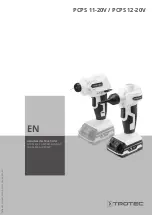
255 of 282
M-SV-001-EN Rev. G
5.4 Compressor Connection Status Indications
• Disconnected: no connection exists with a compressor or remote compressor host
• Ready to Connect: a connection with a remote host (if applicable) has been established, but no
compressor connection has yet been established
• Compressor is starting up: The currently connected compressor is in startup mode
• Connected: There has been established a connection with a remote host (if applicable) and a
connection with a compressor has been established and verified
• No compressor found: Any serial ports or connections have been established, but a valid
compressor was not able to be detected
• Error opening port: There was an error opening the specified serial port (either the port is
already in use, the port name doesn’t exist, or there was some other error attempting to open
the serial port)
• Server not found: Could not connect to remote host
5.5 System and Compressor Level Troubleshooting
5.5.1 Compressor Voltage Troubleshooting
1. Carefully, remove the Mains Input Cover.
2. Verify all three phases of voltage before the mains fuses. Refer to Section "4.12.1 3-Phase Main
Voltage Input Terminal Block Verification" on page 96.
• If the name plate rated voltage is present, proceed to Step 3.
• If the voltage is (+/- 10%) outside of the nameplate rated voltage, restore correct voltage.
3. Verify all three phases of voltage after the mains fuses.
• If the name plate rated voltage is present proceed to Step 4.
• If any of the three phases are not present, isolate compressor power then replace the fuses.
4. Isolate the compressor power as described in the "1.8 Electrical Isolation" on page 19 of this
manual.
5. Inspect all electronics for visible damage
• If no visible damage is present, proceed to Step 6.
• If there is any type of visible damage, replace the damaged component(s).
6. Verify all of the Soft Start fuses (Closed Top only). Refer to Section "4.12.1 3-Phase Main Voltage
Input Terminal Block Verification" on page 96.
• If all of the fuses are okay, proceed to Step 7.
• If any of the fuses are blown, replace the fuse(s) and review the cause of the blown fuses.
Refer to "5.5.2.6 Determining the Cause of Blown Soft Start Fuses (Closed-Top Soft Start
7. Verify the Inverter cable to the Inverter connector is installed correctly.
8. Verify the DC-DC Converter resistances. Refer to "4.25.2 DC-DC Converter Verification" on page
• If DC-DC Converter resistances are correct, proceed to Step 9.
• If DC-DC Converter resistances are not correct, replace the DC-DC Converter then verify the
PWM and bearings.
9. Install the DC Bus test harness. Refer to "1.10.1 General Verification and Installation of the DC
10. Disconnect the J2 (250VDC) and J3 (24VDC) (Potted DC-DC) or J4 (24VDC) Open Frame DC-DC)
outputs from the DC-DC Converter.
11. Re-install the Top Cover then re-apply the compressor power.
12. Verify the DC Bus voltage through the test harness. Refer to "4.22.2 DC Bus Voltage Verification"
Summary of Contents for TGH285
Page 14: ...14 of 282 M SV 001 EN Rev G THIS PAGE INTENTIONALLY LEFT BLANK ...
Page 30: ...30 of 282 M SV 001 EN Rev G THIS PAGE INTENTIONALLY LEFT BLANK ...
Page 38: ...38 of 282 M SV 001 EN Rev G THIS PAGE INTENTIONALLY LEFT BLANK ...
Page 40: ...40 of 282 M SV 001 EN Rev G THIS PAGE INTENTIONALLY LEFT BLANK ...
Page 46: ...46 of 282 M SV 001 EN Rev G THIS PAGE INTENTIONALLY LEFT BLANK ...
Page 50: ...50 of 282 M SV 001 EN Rev G THIS PAGE INTENTIONALLY LEFT BLANK ...
Page 238: ...238 of 282 M SV 001 EN Rev G THIS PAGE INTENTIONALLY LEFT BLANK ...
Page 240: ...240 of 282 M SV 001 EN Rev G THIS PAGE INTENTIONALLY LEFT BLANK ...
Page 260: ...260 of 282 M SV 001 EN Rev G THIS PAGE INTENTIONALLY LEFT BLANK ...
Page 262: ...262 of 282 M SV 001 EN Rev G THIS PAGE INTENTIONALLY LEFT BLANK ...
Page 268: ...268 of 282 M SV 001 EN Rev G THIS PAGE INTENTIONALLY LEFT BLANK ...
Page 276: ...276 of 282 M SV 001 EN Rev G THIS PAGE INTENTIONALLY LEFT BLANK ...
Page 280: ...280 of 282 M SV 001 EN Rev G THIS PAGE INTENTIONALLY LEFT BLANK ...
















































